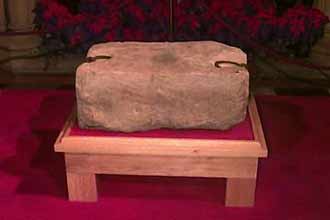|
揭秘苏格兰最伟大的民族象征
[ 2007-04-18 11:22 ]
 The Stone of Destiny has been revered for centuries as a holy relic, fought over by nations and used successively by Dalriadic, Scottish, English and British monarchs as an important part of their enthronement ceremonies. At first sight, it is difficult to understand why this plain and rather unremarkable block of sandstone has fired the passion that it has over the past 700 years. Yet the power and importance of the Stone (also known as the Stone of Scone) far outstrips its physical appearance. It is arguably the greatest symbol and touchstone of Scottish nationhood and as such, has been a very potent icon for more than a thousand years. The Stone of Destiny has been revered for centuries as a holy relic, fought over by nations and used successively by Dalriadic, Scottish, English and British monarchs as an important part of their enthronement ceremonies. At first sight, it is difficult to understand why this plain and rather unremarkable block of sandstone has fired the passion that it has over the past 700 years. Yet the power and importance of the Stone (also known as the Stone of Scone) far outstrips its physical appearance. It is arguably the greatest symbol and touchstone of Scottish nationhood and as such, has been a very potent icon for more than a thousand years.
Early History
Like much of what is now 'uniquely Scottish', the origins of the Stone have been lost to history and typically, there are legends aplenty concerning it. One theory grants it biblical origins while others have it produced in various parts of Ireland and Scotland. In so far as any of its early history is clear, it seems that the Stone was used at Iona, Dunadd, Dunstaffnage and Scone for enthroning a succession of Dalriadic and subsequent monarchs. In 1292 John Balliol became the last king to use the Stone in Scotland as it was captured by Edward I of England in 1296, taken south alongside other important relics of nationhood and placed in Westminster Abbey. There it remained for the next 700 years, a part of the throne of Edward the Confessor on which all new sovereigns sit during their coronation. The last time it was used was at the coronation of HM The Queen in 1953.
The Stone Returns Home...
On St Andrews Day, 30 November 1996, the Stone of Destiny returned north of the border and amid much pomp and ceremony, was installed in Edinburgh Castle, taking its place alongside those other symbols of national identity, the Honours of Scotland. About 10,000 people lined the Royal Mile to watch the procession of dignitaries and troops escort the stone from the Palace of Holyroodhouse to the castle. In a service at St Giles cathedral, the Church of Scotland Moderator, the Right Reverend John MacIndoe, formally accepted the Stone's return, saying it would 'strengthen the proud distinctiveness of the people of Scotland'.
...Or Does It?
The question is, was it the real Stone that was returned? There have been doubts over the Stone's authenticity ever since The Hammer of the Scots carried it off as war booty. Some historians claim that by a cunning sleight-of-hand, the Scots actually handed Edward the cess-pit cover from Scone Castle rather than the real Stone (which if true, means that a long succession of English and British monarchs have been crowned while atop a medieval toilet-seat lid!). The picture is further blurred by the fact that on Christmas Day 1950, four nationalist students stole the Stone from Westminster Abbey and drove it north. It resurfaced some four months later following a huge public outcry, having been deposited by the thieves in Arbroath Abbey, draped in a saltire. The rumour mill was quickly in action and it was suggested that the recovered stone, now safely restored beneath the Coronation Throne at Westminster, was in fact a copy. At least one acknowledged copy of the Stone does exist, on public display at Scone Palace in Perthshire, where it serves as a favourite roost for the elegant peacocks and camera-toting tourists who stroll the grounds. As to whether other copies exist, only the Christmas Day thieves know and they're not saying...
点击查看本频道更多精彩内容
|